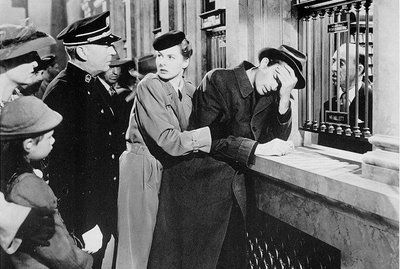Spellbound: 21 Club Southside Cocktail Recipe 🥁🥁🥁🥁
/Year Released: 1945
Directed by: Alfred Hitchcock
Starring: Ingrid Bergman, Gregory Peck, Leo G. Carroll, Michael Chekhov
(Not Rated, 101 min.

"Women make the best psychoanalysts, until they fall in love. Then they make the best patients." Dr. Alex Brulov
One of Alfred Hitchcock’s first American films, this 1945 classic delves into the unconscious to uncover a crime. All the clues are locked in the memory of a profoundly disturbed amnesiac who may or may not be a murderer. But that doesn’t stop our determined psychoanalyst from risking her life and career to help the man she has come to love.
Something seems amiss when the new director of Green Manors arrives at the posh mental asylum in Vermount. Dr. Edwardes (Gergory Peck) seems too young and altogether too vague in his responses to the staff’s questions, especially in reference to his famous tome The Labyrinth of the Guilt Complex. He seems more relaxed at dinner small talk among his new colleagues until Dr. Constance Peterson (Ingrid Bergman) traces something on the white tablecloth with her fork. Not only does he rudely rebuke her for this, but Dr. Peterson also notes than he tries to obliterate the impression by smoothing it out with his butter knife.
The next day, however, he asks her to show him the grounds, and it is obvious that there is magic between them. But just as their love begins to bloom, so does Dr. Edwardes’ bizarre behavior, leading Dr. Peterson to conclude he is not the real Dr. Edwardes, who now it seems has disappeared under suspicious circumstances.
The fauux Dr. Edwardes confesses that he does not really know who he is and he leaves a note to Constance telling her he is going to New York to try to find out. Constance follows, knowing she can help him find the truth he is seeking. Of course, by this time, the disappearance of the real Dr. Edwardes has made the news, and the two are fugitives, trying desperately to unlock memories before they themselves are locked up.
The role of Dr. Peterson is pivotal, and it is both visionary and dated. First of all, although there is a certain prim and perhaps repressed impression in our initial encounters with her, Dr. Peterson is not the icy blond that appears so often in Hitchcock – Kim Novak in Vertigo, Tippi Hedren in Marnie, or Eva Marie Saint in North by Northwest. And she is certainly more intellectual and professional than his typical female lead. In fact, Dr. Peterson is the love interest and the protagonist both, while Gregory Peck’s faux Dr. Edwardes, who has a case of the vapors every time he sees parallel lines against a white background, seems to play the part of the passive, fainting female.
On the other hand, Hitchcock paints Dr. Peterson’s intellectual detachment as a sort of flaw. Certainly it is one that her male colleagues plague her about, at least a certain Dr. Fleurot (Paul Harvey), who mocks and flirts with her in equal measure about it. To our modern mind, the sexism of the all male professional staff at the hospital seems patronizing and chauvinistic, yet there is a certain exhilaration in this absence of political correctness.
Of course, when Dr. Peterson falls in love, she loses this repression like a butterfly emerging from a cocoon, although there are times when she dons her psychiatrist’s hat to lecture the faux Edwardes, whose real name terms out to be John Balantine. He does not react well to her sudden relapse into white-coated prattling, reverting himself to some comfortable sexism: “If there is anything I hate, it’s a smug woman.”
Even her mentor, the charming Dr. Brulov (Michael Chekhov), to whom she flees for help, is bursting with sexism, but with his charming Viennese accent and avuncular charm, it is endearing more than anything else. Especially since he is right in that her love has completely overtaken any detached professional judgment. When he chortles, “Women make the best psychoanalysts, until they fall in love. Then they make the best patients, “ we agree inwardly, albeit a bit guiltily. Perhaps he takes it a bit far, however when he tells her: “We both know that the mind of a woman in love is operating on the lowest level of the intellect.” He accepts the couple to his house with warm hopstitality, bidding them ”Good night and sweet dreams…which we will analyze at breakfast.”
And actually, that’s exactly what they do, and this one is a doozy. The dream sequence was designed by none other than the famous surrealist painter, Salvador Dali, who created a spectacular scene ringed with curtains featuring giant eyeballs, like a grand peacock’s tail, which are cut in half. Too bad a ballroom scene with pianos hanging from the ceiling was left out, and Dali’s idea about having statues cracking with ants emerging along with Ingrid Bergman’s body covered in them was rejected by Hitchcock.
Perhaps a bit dated and heavy handed at times, this is one of Hitchcock’s minor classics, one that will keep you in suspense as it unfolds, holding you as well as Gregory Peck spellbound.
—Kathy Borich

Film-Loving Foodie
Salvador Dali’s dream sequence was specially commissioned for Hitchcock’s film and is one of the most memorable scenes from Spellbound. It is filled with psychoanalytic symbols – eyes, curtains, scissors, playing cards, a man with no face, and a man falling off a building. Dr. Peterson remembers the card game featuring a hand of clubs worth 21 points and ultimately realizes this points to the 21 Club in New York. This is a clue that finally helps her realize just who has killed Dr. Edwards.
Let’s celebrate the success of our intrepid Dream Detective with the signature cocktail from that elite club ourselves, the famous Southside Cocktail.
21 Club Southside Cocktail
Ingredients
2 oz. vodka or gin or white rum
juice of one lemon
2 tsp. of granulated sugar
1 tbsp. Fresh mint leaves
Method
Place all ingredients in a shaker, and shake vigorously to bruise mint leaves.
Strain into a chilled Tom Collins glass filled with ice.
Recipe Source: 21 club.com
















